by Amineddoleh & Associates LLC | Jul 9, 2024 |
Spain’s most exciting art exhibition of the summer is not in Barcelona. It’s not even in Madrid. Instead, the summer’s hottest art excursion is in a deconsecrated and incomplete cathedral in Alba de Tormes, a small town that is a two-hour drive from Madrid.

Alba de Tormes. Image courtesy of Frayle via Wikimedia Commons.
El Esplendor de La Pintura en Valenica
The exhibition, titled El Esplendor de La Pintura en Valenica (The Splendor of Painting in Valencia), highlights artists from Valencia in the late 15th and early 16th centuries. It demonstrates how the arrival of Italian and Flemish artistic influences at this time provided the spark needed to set the Spanish Renaissance ablaze. (Note for readers under the age of 16: Valencia is not just an Instagram filter – it’s also a beautiful municipality in Spain!)
This breathtaking exhibition features a monumental 120 pieces of Renaissance works, 90% of which have never been on display. Nothing like this has ever been accomplished in Alba before – and the exhibition’s success has made the international art world pay attention.
Two primary aspects of this exhibition make it stand out. The first is that the art on display is remarkable. The focal point of the exhibition is a painting of Christ tied to the pillar by Juan de Juanes. It is largely regarded as his best work, as well as a true pillar of the Spanish Renaissance canon. The painting is accompanied by an augmented reality rendition of the prized work. In an immersive video located in a nearby booth, viewers are treated to a life-like vision of Christ suffering. Christ stares soulfully into the eyes of the viewer, while tilting a head made heavy by a crown of thorns, and lifting bound wrists. This effect is powerful – and enough to send even the most pious attendees scurrying to Mass.
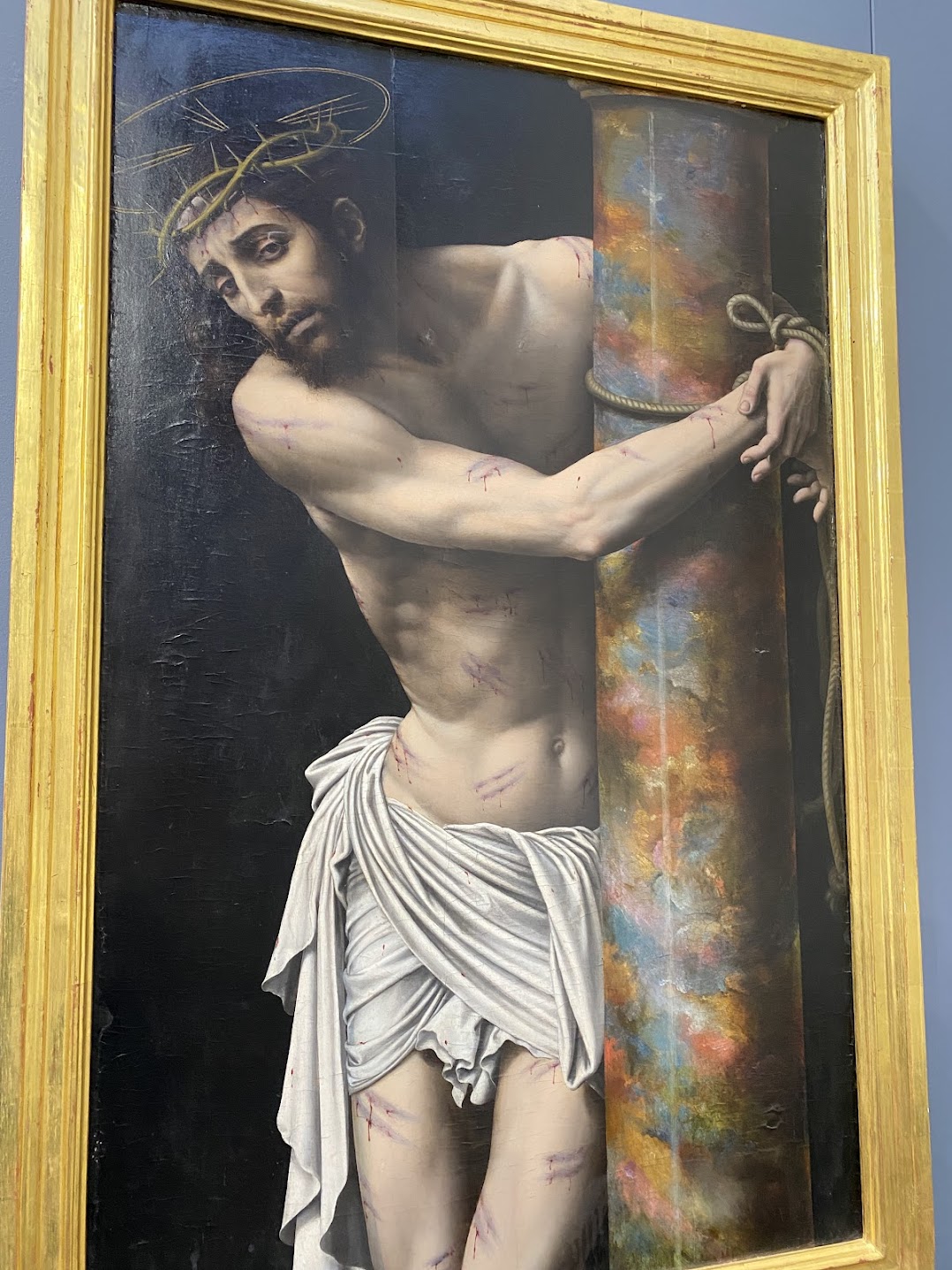
“Christ tied to the Column” by Juan de Juanes. Copyright: Leila A. Amineddoleh
In addition to Juan de Juanes’ pivotal work and its augmented reality counterpart, other priceless works fill the cavernous space. One wonders how such a thoughtfully curated collection came together. Many works are on-loan from private collections (the centuries-old altarpieces, for example, are a particular coup and a true treat for the senses). In fact, the collection is so triumphant in its significance and rarity that it alone makes a trip to Alba a definite “must” for anyone in Spain this summer. Which leads to the second reason this exhibition is garnering so much buzz in the art world.
Alba is a beautiful city, known for being a haven for painters and artists in the 16th century (who all flocked to bask in the aura of the ineffable Duke of Alba). Not only that, Alba is known for housing renowned Catholic saints St. Teresa of Avila and Saint John of the Cross. Despite all of this history, the city is still rarely considered a tourist site.
Tourism and Depopulation
The decision to hold the exhibition in Alba, then, was a response to what’s known as la España vaciada or “hollowed-out Spain.” This term is used to describe the depopulation happening across the country of certain areas. As citizens leave rural areas in favor of big city life, smaller towns face a host of problems: unemployment issues, reduced or eliminated services, closed restaurants and shops, and desolate downtown urban areas. But one unfortunate side effect less-frequently talked about is the threat depopulation poses to art and cultural heritage.
Our founder wrote a well-informed (and prescient) note on this topic (available here). But for those who are new to the subject, the depopulation of culturally rich areas puts the art and cultural heritage left behind at risk of theft, environmental destruction, and intentional or accidental demolition – just to name a few. Abandoned cultural sites and works of art are easily targeted by looters and bored civilians alike. The result is the heartbreaking loss of irreplaceable worldly treasures.
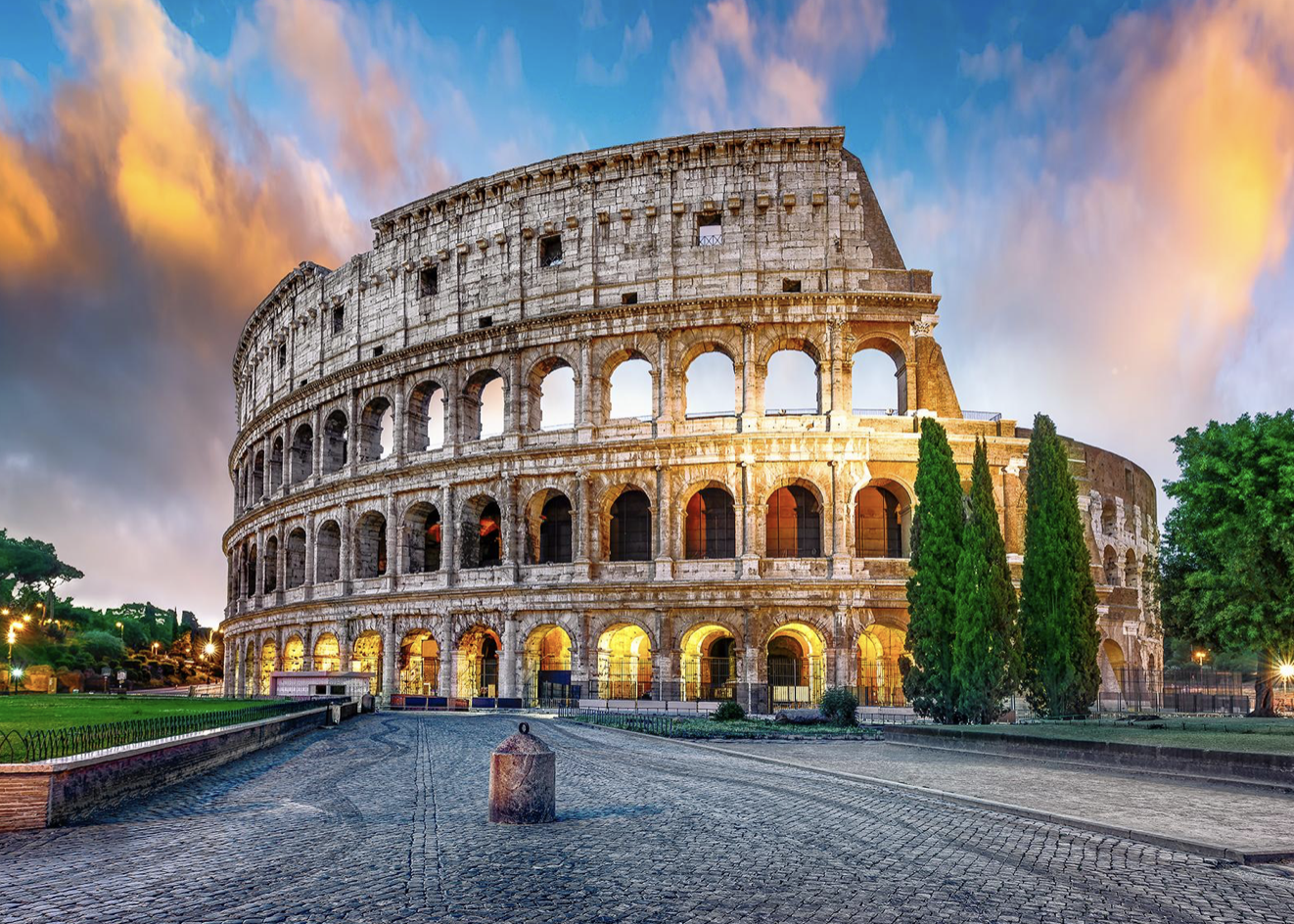
The Colosseum in Rome is a heavily-touristed site. Image via Fodor’s, available at https://www.fodors.com/world/europe/italy/rome/experiences/news/photos/the-10-best-ancient-sites-in-rome.
One solution to this damage that comes from depopulation is to re-direct tourism to these areas from highly popular sites. When tourism booms in the same areas over and over, a whole host of other issues ensues (Our firm has written at length on that topic here – click to brush up on the dangers of overtourism, including destruction of cultural sites due to wear-and-tear, as well as vandalism).
When tourism is instead spread out to more places, the risks to cultural heritage from overtourism are mitigated. Moreover, the economic benefits of tourism – and the boom it can provide to local economies – is more evenly spread out around the country.
This move to a more sustainable form of tourism does not happen naturally. Rather, it requires concentrated efforts from dedicated groups and individuals on the front lines. Immersive knowledge of a place and its most significant features are essential to breathing life into new spaces, in order to create new patterns of tourism.
Reliance on Local Experts
Nicolas Cortés, a 30-year veteran of the art world, is one of these individuals, and an organizer of the Valencia exhibition. His vision for this particular effort was, in his words, to expose people to high-quality art, as well as to the beautiful city of Alba itself. For Cortés, “it’s also about the environment. We want people to come to beautiful places [like Alba de Tormes] so they can get to know them.”

El Monasterio de la Anunciación de Nuestra Señora de Carmelitas Descalzas de Alba de Tormes. Image courtesy of Fundacion Declausura.
Cortés’s work is particularly important in Spain, where lack of Spanish involvement in international treaties has led to a disinterest in the international art world over the protection and preservation of Spanish artistic treasures. Additionally, many of the art and cultural heritage at-risk due to depopulation is held by the Church, and thus out-of-reach for State actors.
This is why the Valencia exhibition is such an artistic powerhouse – bringing culture to an area experiencing the negative impacts of depopulation, in a way that draws upon locals to help with daily operations and revitalizes the town’s economy. It features artists such as Gonçal Peris, Joan Reixach, Maestro de Artés, Yáñez de la Almedina, Martín Gómez, Paolo de San Leocadio and (of course) Juan de Juanes. In the words of the exhibition’s curator, José Gómez Frechina, the arrival of foreign works in Valencia “struck the city like a bolt of lightning, illuminating the way for all the painters there”. The resulting exhibition is a lighting strike itself. In short, it is worth a two-hours’ drive from Madrid.
Efforts Made by Turkey
Spain is not the only international location using tactics like this to divert tourists from over-touristed areas, In Turkey, for example, Istanbul’s city-wide restoration teams have painstakingly restored new attractions to bring tourism to little-known historical and cultural sites in the city.

Gülhane Park Cistern. Image courtesy of thebyzantinelegacy.com.
Istanbul is ripe to benefit from shifting tourism patterns (fun fact: Istanbul is currently the #1 most-visited city in the world), because Istanbul is a city of multiple layers. This means that there is always something new for the city to feature – and for tourists to discover. Most tourists rush to the Basilica Cistern upon arrival, as the city’s most famous cistern. However, just a 12-minute walk away is the Gülhane Park Cistern, a 1,500-year-old reservoir that has been restored by the city and recently reopened to the public in 2023. The Gülhane Park Cistern is ensconced inside a gorgeous green area that was once part of the private Topkapi Palace (also home to the Column of the Goths, a Roman monument, and the Alay Köşkü, a former favorite hang-out of 16th century Ottoman sultans).
By directing tourists to these, lesser-known but highly-valuable cultural sites, the municipality is able to relieve the burden of overtourism to a site like the Basilica Cistern – while still providing a memorable and invigorating experience to the visitors.
Sustainable Tourism
Dedicated efforts like these by cities and municipalities (when possible) and by individuals and nonprofits (when applicable) serve to mitigate the impacts of overtourism to popular sites. They also aim to correct issues caused by depopulation of rural areas. The combined impact protects cultural heritage on two fronts – providing a wonderful model for sustainable tourism moving forward.
Plus, who needs another photo of the Trevi Fountain? This summer, all the cool kids are at the Valencia exhibit in Alba – just check our firm’s socials for proof.
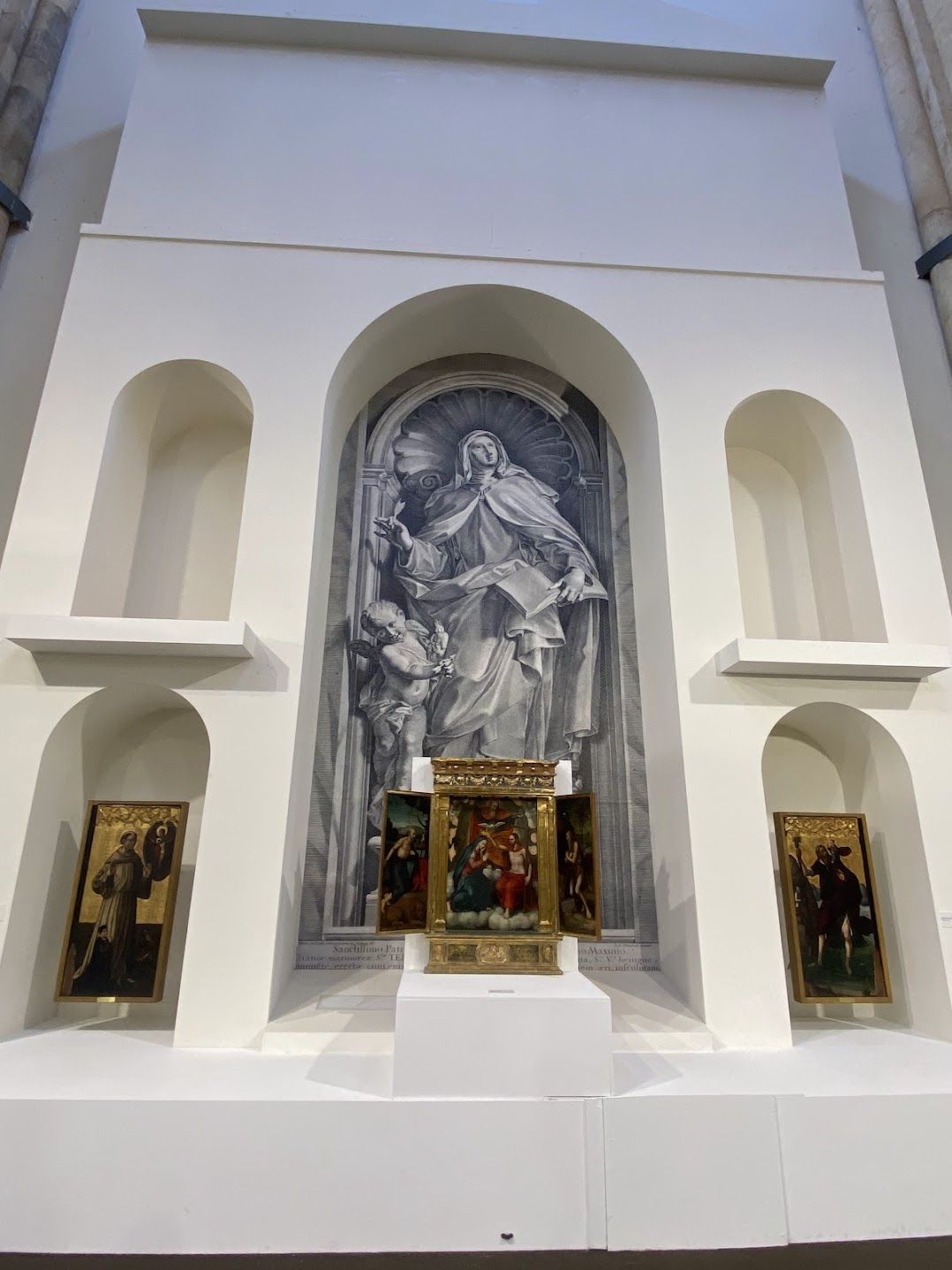
Altarpiece at El Esplendor de La Pintura en Valancia. Copyright: Leila A. Amineddoleh
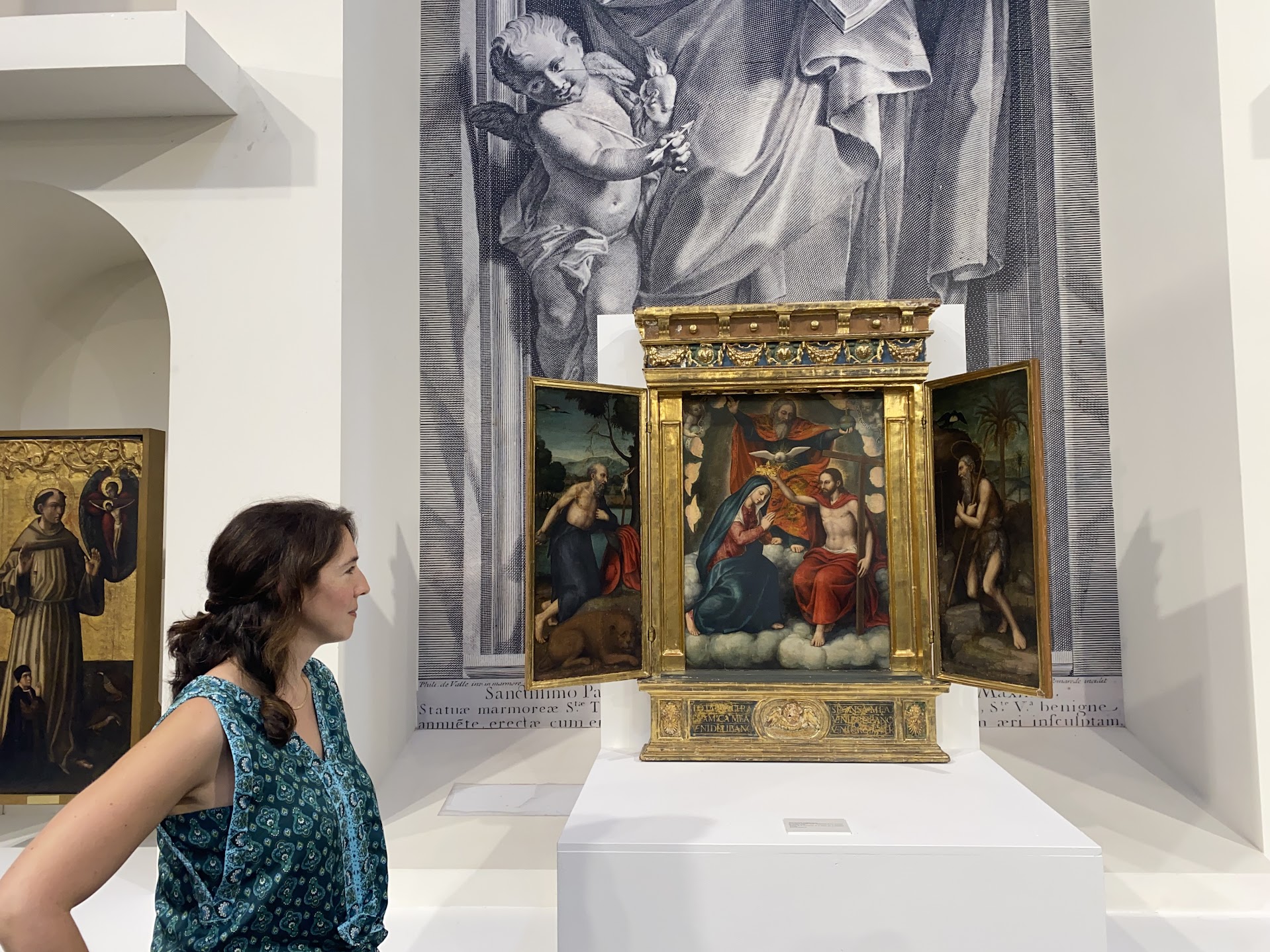
Our founder at the opening reception of El Esplendor de La Pintura en Valencia.
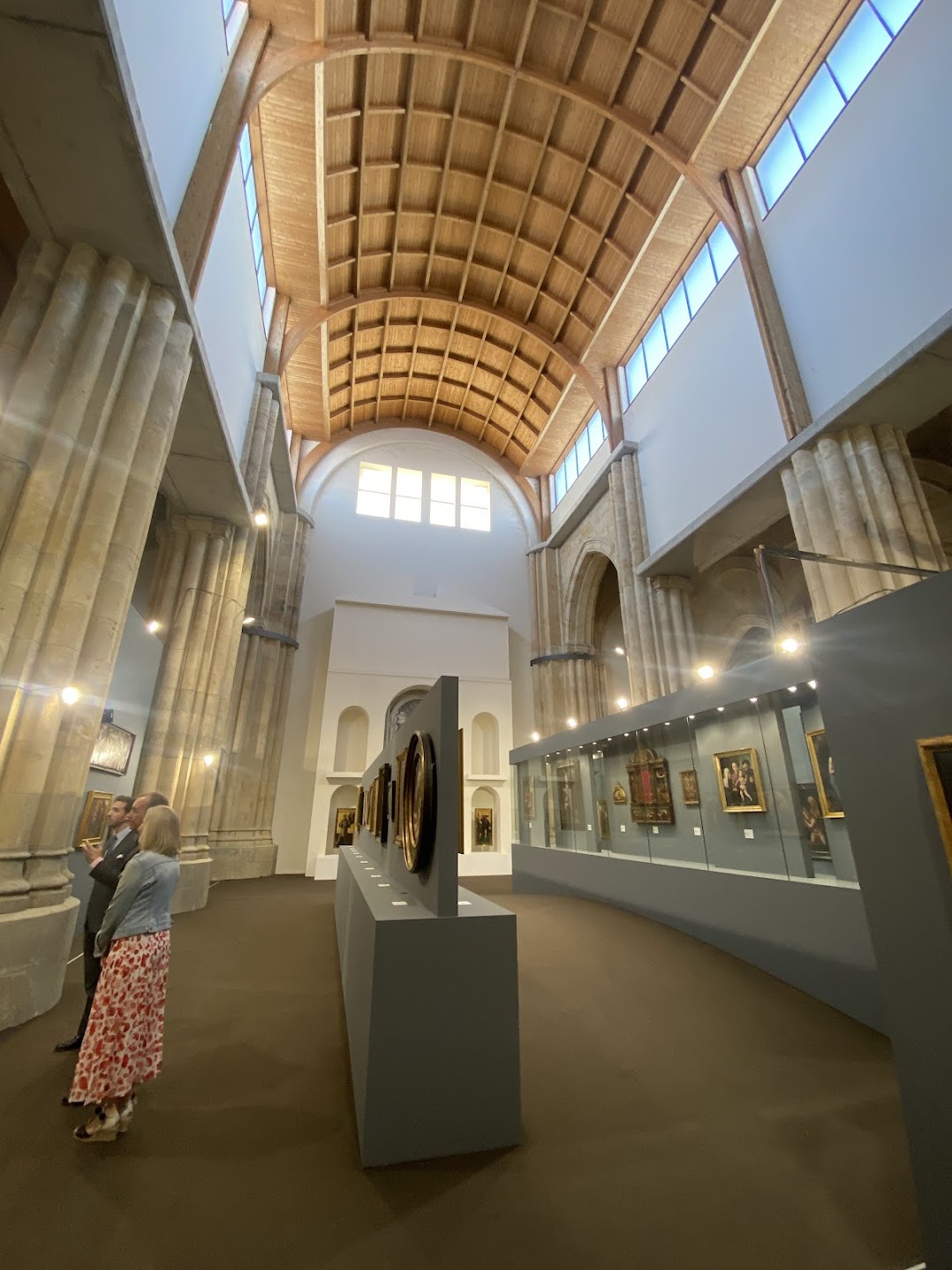
The Mayor of Alba de Tormes enjoying a tour of the exhibition. Copyright: Leila A. Amineddoleh
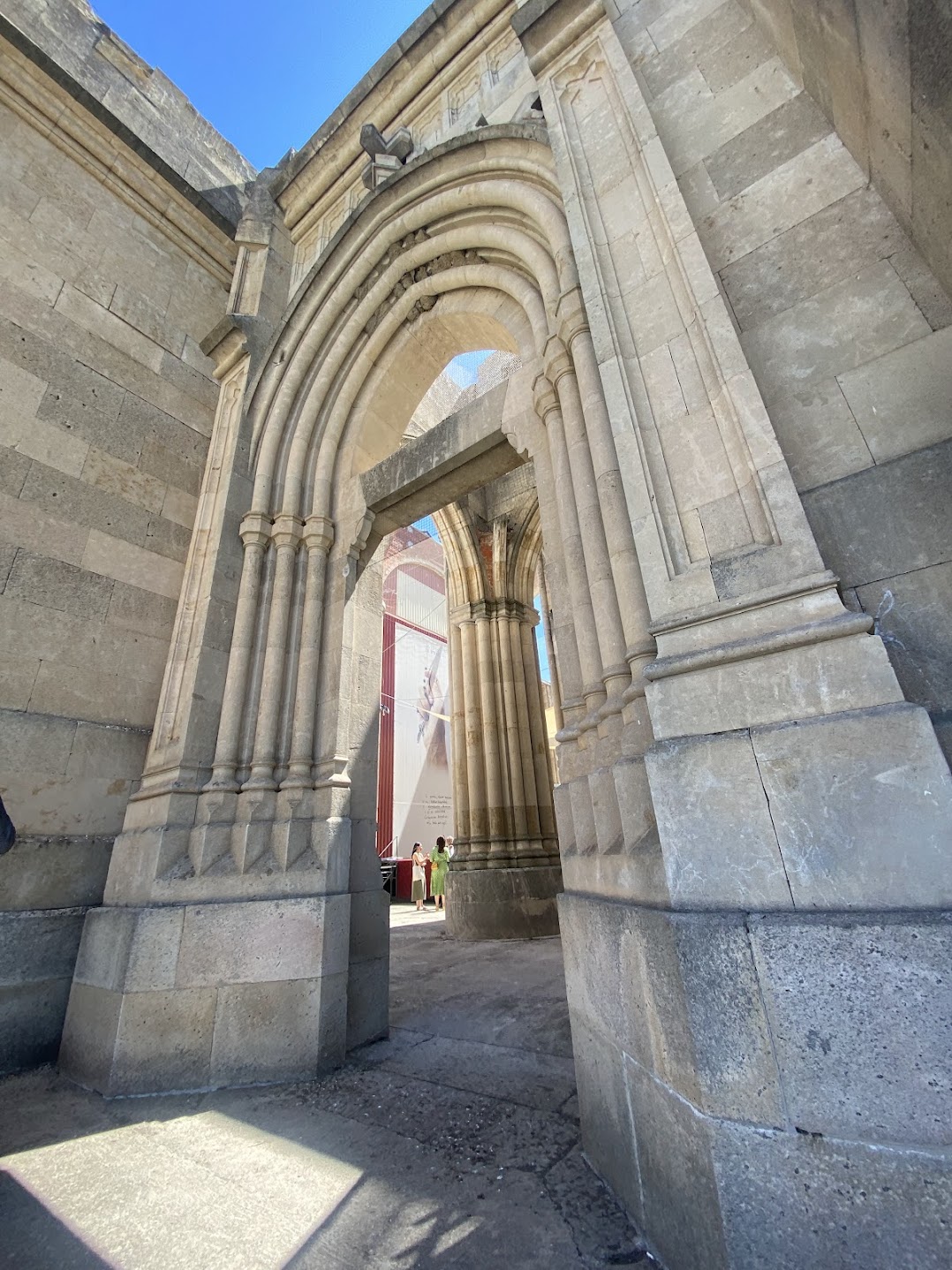
Entry to the exhibition. Copyright: Leila A. Amineddoleh
by Amineddoleh & Associates LLC | May 15, 2024 |
Last week, a painting stolen over forty years ago was finally returned to its original owner, Chatsworth House. The painting, A Double Portrait of Sir Peter Paul Rubens and Sir Anthony Van Dyck (1640s) by Eramus Quelliness II, was stolen on May 26, 1979, and recently discovered at a regional auction house in France. Chatsworth House lent the work to the Towner Art Gallery for an exhibition featuring works by the Flemish Baroque artist Anthony Van Dyck.

Eramus Quelliness II’s A Double Portrait of Sir Peter Paul Rubens and Sir Anthony Van Dyck (1640s). Image via Chatsworth House Trust.
“Smash and grab”
The exhibition did not go as planned. To the public’s astonishment, the gallery fell victim to a “smash and grab” raid after the exhibition. Thieves made off with A Double Portrait of Sir Peter Paul Rubens and Sir Anthony Van Dyck, but left more valuable works behind – causing authorities to believe that the robbery was not well-planned out. While A Double Portrait looked more expensive than the drawings left behind, the original Van Dyck drawings the thieves left were much more valuable (and have sold for upwards of $2 million in recent years).
The thieves may not have been very knowledgeable about art. Even so, they disappeared without a trace. The painting had been feared lost since that night in May 1979.

Interior of Chatsworth House. Image via Chatsworth House Trust.
Miraculous Recovery
Until now!
In 2021, an art historian discovered that the work was listed for sale in the bucolic town of Toulon, France. They reported the finding to Chatsworth House, who happily stepped forward to claim the work.
It’s unclear how the piece made its way from the thieves to modern-day France. The Art Newspaper reports that the painting was sent to Toulon to be sold after the seller discovered it while cleaning out his late parent’s house.
The painting required extensive restoration. Today, the work shines with its former glory.

Collectible from Chatsworth House. Image via Chatsworth House Trust.
The Art Loss Register
This was a happy ending to a devastating art robbery. Art crime continues to plague valuable collections in public and private collections all over the world. To combat the problem, the Art Loss Register (ALR) currently holds and maintains the largest private database of lost, stolen, and looted art, antiquities and collectibles.
Works are added to the registry on behalf of victims of looting and theft, insurers, police forces and other interested parties. ALR also employs a unique due diligence service for their clients who are active in the art market to ensure that they are handling objects that do not have questionable provenance.
The ALR single-handedly provides the art industry’s best risk management tool for those seeking to buy and sell works of art and cultural heritage. Moreover, using ALR’s tools and databases speeds up recovery of missing works, because searching the database enables users to identify works that have been stolen – and to return them to their claimant for recovery.
To read more about how ALR helps its clients search, register and recover lost art, click here.
by Amineddoleh & Associates LLC | Mar 5, 2024 |
In honor of International Women’s Day and Women’s History Month, our firm is reposting one of our favorite blog posts. This post originally ran on our firm’s blog in 2021.
—
It is a bitter truth that women, who are so often depicted, admired and romanticized through art, have had to overcome herculean obstacles to participate in its creation. In honor of Women’s History Month, this entry in our Provenance Series examines the work of the Old Masters’ female counterparts – the Old Mistresses – and their contemporary successors.
Rediscovery of Female Artists
Renaissance and Baroque works by women have deservedly entered the public consciousness in recent years. In 2019, a depiction of the Last Supper by nun Plautilla Nelli was installed in the Santa Maria Novella Museum in Florence, after a painstaking 4-year restoration by the Advancing Women Artists Foundation (AWA). The project was made possible through the AWA’s “adopt an apostle” crowdsourcing program: private financiers were allowed to “adopt” one of the life-sized disciples at $10,000 each (ever-unpopular Judas was instead funded by 10 backers at only $1,000 each). The oil painting, measuring 21 feet across, is one of the largest Renaissance works by a female artist still in existence. It is also the only work created by a woman during the Renaissance depicting the Last Supper.

Last Supper by Plautilla Nelli (prior to restoration). Image via My Modern Met.
The Provenance and Restoration of Plautilla Nelli’s The Last Supper
The Last Supper was likely created for the benefit of Plautilla’s own convent, the convent of Santa Caterina di Cafaggio in Florence, where it hung in the refectory (dining hall) until the Napoleonic suppression in the 19th century, when the convent was dissolved. It was thereafter acquired by the Florentine Monastery of Santa Maria Novella in 1817. Again, it was housed in the refectory until being moved to a new location in 1865. Scholar Giovanna Pierattini reports it was moved to storage in 1911, where it remained until 1939. It then underwent significant restoration, and returned to the refectory. It would remain on display there for almost forty years, surviving the historic flood of the Arno in 1966 with little damage. The work was next taken down in 1982, when the refectory was reclassified as the Santa Maria Novella Museum, and transferred to the friars’ private rooms. This is how the monumental work, which remained out of the public eye for centuries, is now visible to the public for the first time in 450 years.
Rossella Lari, the restoration’s head conservator remarks, “We restored the canvas and, while doing so, rediscovered Nelli’s story and her personality. She had powerful brushstrokes and loaded her brushes with paint.” The painting features emotionally charged expressions, emphatic body language, and exquisite details, such as the inclusion of customary Tuscan cuisine (roasted lamb and fava beans).
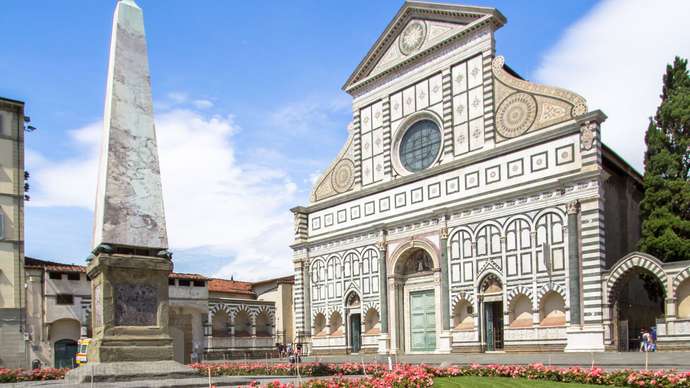
Santa Maria Novella in Florence, Italy. Image courtesy of CAHKT/iStock.com.
Plautilla’s use of color and composition is even more impressive when one considers that women were barred from attending art schools and studying the male nude; instead, they were forced to rely on printed manuals and the works of other artists. Plautilla was not only a self-taught artist, but she also ran an all-woman workshop in her convent and received the ultimate praise for an Italian Renaissance painter: inclusion in Giorgio Vasari’s seminal book Lives of the Most Excellent Painters, Sculptors and Architects. Notably, in Plautilla’s time the convent was managed by Dominican friars previously under the leadership of fire-and-brimstone preacher Girolamo Savonarola. The nuns were encouraged to paint devotional pictures in order to ward off sloth.
Undeterred, “Plautilla knew what she wanted and had control enough of her craft to achieve it,” says Lari. The Last Supper is signed “Sister Plautilla – Orate pro pictora” (“pray for the paintress”). Plautilla thus confirmed her role as an artist while acknowledging her gender, understanding that the two were not mutually exclusive. Although only a handful of the works survive today, Plautilla and her disciples created dozens of large-scale paintings, wood lunettes, book illustrations, and drawings with great focus, determination, and discipline. She is considered the first true woman artist in Florence and in her heyday, “There were so many of her paintings in the houses of gentlemen in Florence, it would be tedious to mention them all.” Since AWA’s conservation work was initiated, the number of works attributed to Plautilla has risen from three to twenty, meaning that other undiscovered masterpieces could be lying in wait.
Female-Led Museum Exhibitions
The Prado Museum in Madrid has hosted an exhibition featuring two overlooked Baroque painters, Sofonisba Anguissola and Lavinia Fontana, in an exhibition entitled “A Tale of Two Women Painters.” Meanwhile, the National Gallery in London hosted a show dedicated to Artemisia Gentileschi. Notably, Sofonisba, Lavinia and Artemisia all achieved fame and renown during their lifetimes, including royal commissions, only to be eclipsed for centuries after their deaths. Sofonisba was particularly sought after for her ability to capture the expressiveness of children and adolescents in intimate portraits, while Lavinia’s commissions displayed a more formal Mannerist style. Artemisia, the subject of the National Gallery’s first major solo show dedicated to the artist, is recognized as much for the strength of her figures in chiaroscuro as for her life story involving sexual assault and trial by torture. Despite considerable difficulties, Artemisia was able to succeed in a male-dominated field and created over 60 works, most of which feature women in positions of power. Artemisia is now hailed as one of the most important painters of her generation and an established Old Mistress in her own right.
Female Artists at Auction
Despite their long slumber in the annals of history, these artists are not only receiving attention in museums, but in auctions as well. In 2019, a painting by Artemisia depicting Roman noblewoman Lucretia shattered records when it sold for more than six times its estimated price at Artcurial in Paris. While estimates originally placed the work at $770,000 to $1 million, the painting was ultimately acquired by a private collector for $6.1 million. Lucretia was discovered in a private art collection in Lyon after remaining unrecognized for 40 years. It was in an “exceptional” state of conservation according to Eric Turquin, an art expert specializing in Old Master paintings previously at Sotheby’s.

Artemisia Gentileschi’s Lucretia (ca. 1630-1640). Image via Getty Museum.
The earlier record for one of Artemisia’s works had been set in 2017, when a painting depicting Saint Catherine sold for $3.6 million. That painting, a self-portrait of the artist, was then acquired by the National Gallery in London for $4.7 million in 2018. This was the first painting by a female artist acquired by the National Gallery since 1991, and the 21st such item in its entire collection, which encompasses thousands of objects. Saint Catherine had been owned by a French family for decades, but its authorship was obscured prior to its rediscovery and sale by auctioneer Christophe Joron-Derem. The painting was acquired by the Boudeville family in the 1930s, but the exact circumstances of this acquisition and the painting’s prior whereabouts were unclear. At the time of the National Gallery’s purchase, museum trustees raised concerns that the work might have been looted during World War II, although there is no firm evidence to support this suspicion. Despite the gaps in the works’ provenance, it was ultimately determined that the painting had been with the family for several generations and Saint Catherine was welcomed to her new home in London.
Recent Attributions
More recently, a painting of David and Goliath was attributed to Artemisia after a conservation studio in London removed layers of dirt, varnish and overpainting to reveal her signature on David’s sword. While the work’s attribution occurred too late for inclusion in the National Gallery exhibition, the owner is apparently delighted to discover the work’s true author and is keen to loan it to an art institution so the public can enjoy the work. This painting was originally acquired at auction for $113,000 and may have been owned by King Charles I – quite an esteemed pedigree and sure to raise its value by a considerable amount.
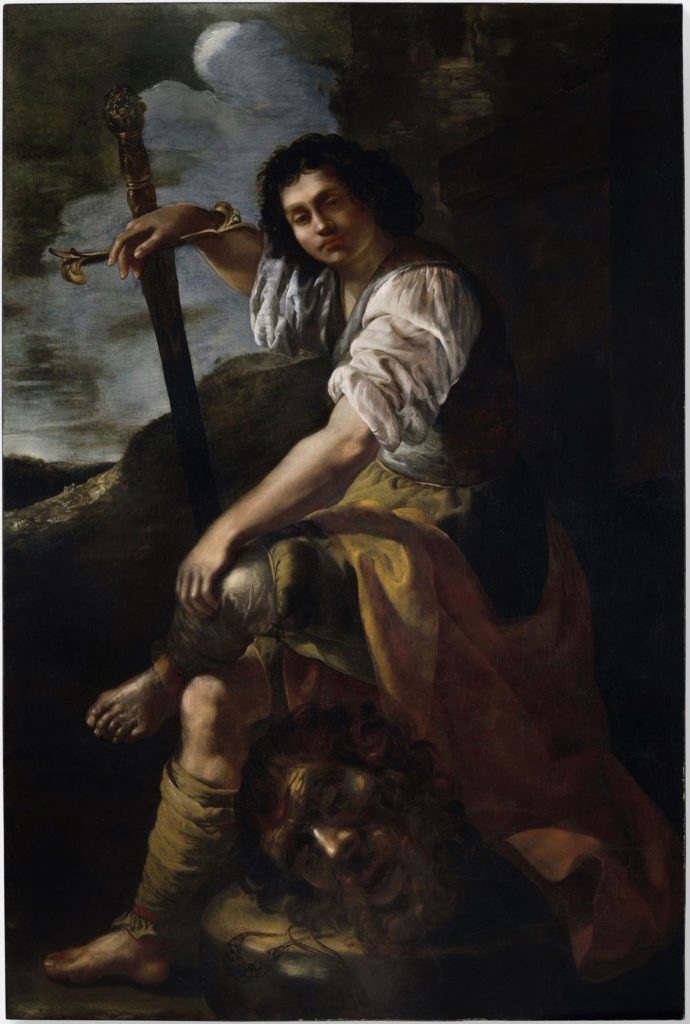
Artemisia Gentileschi, David and Goliath. Image courtesy of Simon Gillespie Studio.
In contrast to Artemisia’s ascendance, a painting once attributed to her father Orazio Gentileschi is now embroiled in controversy. That painting, which also depicts David and Goliath and described as “stunning” by the Artemisia show curator, has links to notorious French dealer Giuliano Ruffini. Ruffini is the subject of an arrest warrant due to his connection with a high-profile Old Master forgery ring operating in Europe. It is believed that the forgery ring, uncovered in 2016, garnered $255 million in sales, including works represented as being by Lucas Cranach the Elder and Parmigianino.
Although these paintings were widely accepted as genuine masterpieces and fooled leading specialists, they did not have verifiable provenances. The paintings were said to belong to private collector André Borie, although that was not the case and Sotheby’s was forced to refund money to buyers once the fraud came to light. The Gentileschi in question had been “discovered” in 2012 and sold to a private collector, who loaned it to the National Gallery in London. At that time, the painting was praised for its “remarkable” lapis lazuli background, but the museum did not conduct a technical analysis before displaying the piece. Despite several warning signs – the painting’s recent entrance into the art market, its unusual material, its similarity to another Gentileschi painting held in Berlin, and the lack of published provenance – the museum stated that there were “no obvious reasons to doubt” the painting’s attribution.
The forgotten nature of some female artists demonstrates that their talents are not rare, but rather that they lack the opportunities and publicity that male artists often take for granted. Once their talent is amplified, female artists are capable of great things. This pattern continues today.
The Modern Struggles of Female Artists
As famous female artists lost to history capture the public eye, they are joined by female contemporaries who share a similar struggle against underrepresentation. Women’s contribution to modern and contemporary art is often exemplifiedby those with ties to established male artists: Mary Cassatt (who achieved recognition as an Impressionist in Paris through her relationship with Edgar Degas); Georgia O’Keeffe (who entered the public eye via her relationship to Alfred Stieglitz); and Frida Kahlo (introduced to the art world by her husband, Diego Rivera). This truncated view ignores the vast amount of creative output generated by women, and reinforces the notion that recognition must be made through a male lens, a view prevalent during Artemisia’s time. It is worth noting that Artemisia’s father Orazio Gentileschi was her teacher and facilitator in the Baroque art market. In fact, this attitude has denied countless female artists of their deserving places in the canon of art history. It has even enabled surreptitious artists to take credit for works by others.
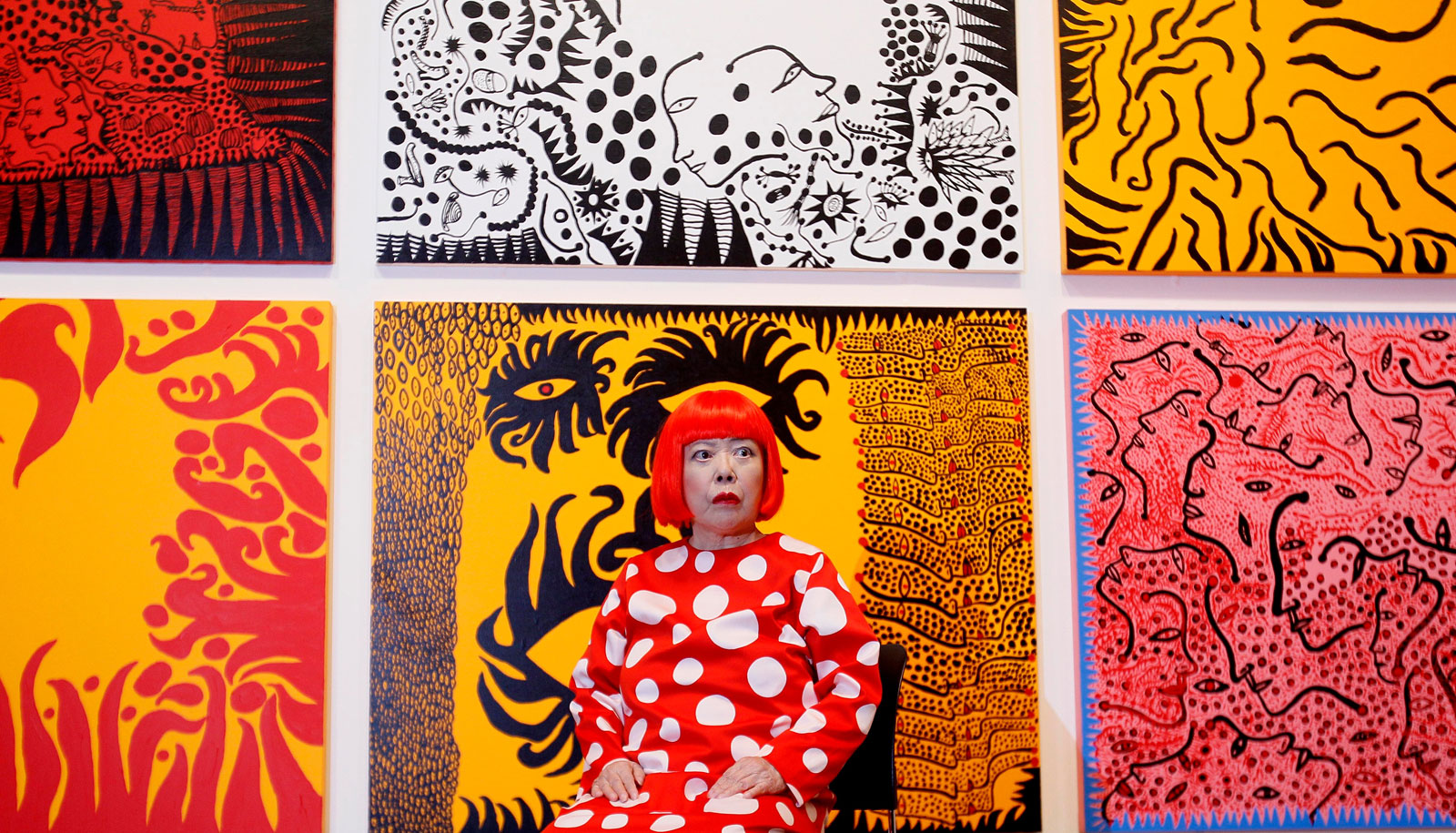
Yayoi Kusama.
Image courtesy of Kirsty Wigglesworth.
Today, Yayoi Kusama is a household name. The world’s top-selling female artist, she is renowned for her peculiar polka-dotted paintings and sculptures, which command long lines at preeminent art institutions across the globe. Like many famous contemporary artists from the last century, she is strongly associated with a unique personal style, and recognized by her bright-red wig. Despite her phenomenal success, her position in the pantheon of notable contemporary artists was anything but assured. Born in the rural town of Matsumoto, Japan in 1929, Kusama was discouraged from pursuing a career; rather, she was encouraged to marry and start a family. Frustrated by the constant efforts to suppress her artistic aspirations, she wrote to the already famous Frida Kahlo for advice. Kahlo warned that she would not find an easy career in the US, but nevertheless urged Kusama to make the trip and present her work to as many interested parties as possible.
Unsurprisingly, Kahlo’s advice was accurate. After traveling to New York, Kusama’s early work received praise from notable artists Donald Judd and Frank Stella, but it failed to achieve commercial success. Her work also attracted the attention of other renowned artists, who were able to channel ‘inspiration’ from Kusama’s work right back into the male-dominated New York art market. Sculptor Claes Oldenburg followed a fabric phallic couch created by Kusama with his own soft sculpture, receiving world acclaim. Andy Warhol repurposed her idea of repetitious use of the same image in a single exhibit for his Cow Wallpaper. Most blatantly, after exhibiting the world’s first mirrored room at the Castellane Gallery, Lucas Samaras exhibited his own mirrored exhibition at the Pace Gallery only months later. Needless to say, these artists did not credit Kusama for her work and originality. This ultimately caused a despondent Kusama to abandon New York and return to Japan.
Kusama spent the next several decades largely in obscurity. The frustrations in her career resulted in multiple suicide attempts and long-term hospitalizations. However, Kusama always found a way to channel this energy back into her art, and she continued to create art in various formats as a way to heal. It was not until a 1989 retrospective of her work in New York and an exhibition at the 1993 Venice Biennale that the world truly tok notice of her work. This global reintroduction was enough to galvanize interest in her artistic creation, leading to the success she enjoys today. While it may seem just that such a talented artist would eventually receive recognition for her work, this is not always a given and Kusama’s near erasure from the art world should not be discounted.
The Gendered Art Market Divide
In today’s art market, artists, collectors, dealers, and museums are making a concerted effort to fight this type of erasure. Kusama stands as a beacon to others, demonstrating that female artists can reach the pinnacle of their profession. However, it remains an arduous career path for many. Statistical analysis confirms that female artists are underpaid and underrepresented in both the primary and secondary art markets. For example, compare the highest price paid for a work by a living artist by gender: Jeff Koons’ Rabbit sold for $91.1 million in 2019; while Jenny Saville’s Propped sold for $12.5 million that same year, a mere 14% of the Koons’ price. Some of this disparity can be explained by the difference between men and women’s treatment in the workplace generally, but the art world is also subject to a number of particularities. Attributed to a host of causes, perhaps none is more prominent than women’s almost total exclusion from studio art until the 1870s. The art world has existed in this environment for so long that its institutions and relationships now mechanically reinforce the disparity between genders: women are less likely to receive recognition and training, and buyers are less interested in art created by females. The interest in female-made art is also disproportionality concentrated on its biggest names; the top five best-selling women in art held 40% of the market for works by women auctioned between 2008 and 2019. It has become a self-sustaining cycle that can only be broken through deliberate and effective action.
Initiatives Supporting Female Artists
Artists and galleries have been working to shine a light on the current landscape of inequality in the market. Groups like the Guerilla Girls have used their cultural status and notoriety to vocalize issues regarding sexism, racism, and other types of discrimination still rampant today. This type of radical-meets-reformer message resonates with a newer generation that is more vocal about addressing discrimination, and frustrated by the seemingly lackluster efforts to minimize their impact on society. In honor of Women’s History Month, several galleries have announced shows dedicated to addressing some of these issues. The Equity Gallery is presenting “FemiNest,” a collection of works by female artists centered around the literal and metaphorical ideas conjured by the idea of a “nest.” The show explores in sculpture, textiles, painting and other media the new spaces that have opened for women in recent decades and their practical and spiritual impact for women. The Brooklyn Museum has announced a retrospective of Marilyn Minter’s work titled “Pretty/Dirty” aimed at challenging traditional notions of feminine beauty. Featuring more than three decades of work, the show will track Minter’s progress throughout the 1970s, 80s, and 90s. The show is also part of a larger series of ten exhibitions by the Brooklyn Museum dedicated to the subject: “A Year of Yes: Reimagining Feminism at the Brooklyn Museum.” Lastly, the Zimmerli Art Museum will feature an exhibition of works by the Guerilla Girls and other female artists who have worked to depict women’s unequal treatment in the art world, “Guerrilla (And Other) Girls: Art/Activism/Attitude.” (For more information about these shows and others addressing similar issues, see here.)
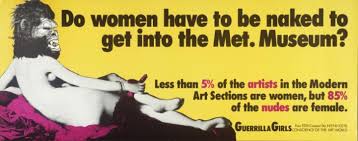
Do Women Have To Be Naked To Get Into the Met. Museum? (1989), Guerrilla Girls. Image via the Met.
Although artists and art institutions have just begun the work of winding back centuries of discrimination, there is evidence that their work is already affecting the market. The percentage of female-generated artwork in the secondary market is increasing from year to year; from 2008 to 2018, the market more than doubled from $230 million to $595 million. Similarly, representation of women at major art shows is steadily, if inconsistently, increasing as well. This subtle shift in the market has been attributed at least in part to a new class of art purchaser: independently wealthy women, whose capital is self-made rather than inherited or shared via marriage. This novel source of demand is less sensitive to the traditional pressures of the market and is helping to fuel demand for works by female artists. Women’s History Month is an opportunity to reflect on the tremendous progress made by remarkable individuals in the art world, and to also contemplate the ripe opportunities that still lie ahead.
by Amineddoleh & Associates LLC | Jan 30, 2024 |

Nu Couché au coussin Bleu by Modigliani. Image via Artsy.
For years, the art world watched the dispute between Russian oligarch Dimitry Rybolovlev and Swiss shipper-turned-dealer Yves Bouvier. While their relationship’s start seemed fruitful and equally beneficial as it led to Rybolovlev’s acquisition of some of the most highly sought-after art treasures, the tide turned when the Russian billionaire discovered that Bouvier had been dishonest about information related to arts sales. Rybolovlev began a legal battle, engaging in scorched earth tactics to pursue claims against Bouvier in jurisdictions around the world. With allegations by a billionaire collector against one of the art world’s best known freeport owners and lavish dealers, many players in the art world were swept up in the fight.
At the heart of the dispute is whether Bouvier committed fraud and breached a fiduciary duty to Rybolovlev. The Russian collector alleges Bouvier flipped high-end artworks that he significantly marked up, although Bouvier represented to Rybolovlev that he was only making a 2% commission on the sales. In some instances, Bouvier concealed the fact that he or one of his shell companies had purchased the artwork shortly before selling it to Rybolovlev. The Russian billionaire alleges this was fraudulent. In addition, the collector argues that Bouvier breached his fiduciary duty because he was the seller, despite Rybolovlev’s belief that Bouvier was serving as his agent and advisor, not as a party with an ownership interest. Bouvier argues he was not Rybolovlev’s agent or advisor. The bounds of the relationship are not clear.
A scorned Rybolovlev filed charges about Bouvier in numerous countries. Eventually, Bouvier was arrested on criminal charges in Monaco in 2015 but was released. Equally salacious were Rybolovlev’s attempts to have authorities prosecute Bouvier, leading to claims that the Russian collector bribed law enforcement to pursue the case against Bouvier. It became known as “Monaco-gate.”
Eventually, Rybolovlev’s legal claims against Bouvier were either dismissed or settled, with the last one settled in December 2023 over claims filed in the United States. However, Rybolovlev felt wronged and thought others were complicit in supporting Bouvier’s fraud, and thus outstanding legal issues remained concerning other parties that were allegedly part of a fraud orchestrated by Bouvier. As Sotheby’s worked with Bouvier to conduct private sales to the collector, Rybolovlev sued one of the world’s leading auction houses in the Southern District of N.Y. (Accent Delight Int’l v. Sotheby’s, 18-CV-9011 (JMF) (S.D.N.Y. Nov. 21, 2023). The highly anticipated trial began during the second week of 2024. Closing arguments took place on Monday with the jury deciding the verdict in under 6 hours on Tuesday, January 30.

One of the works Rybololev purchased. Tête by Modigliani. Image via Sotheby’s.com.
WHAT WERE THE ALLEGATIONS AGAINST SOTHEBY’S?
Rybolovlev sought $377 million in damages from Sotheby’s, alleging that the famed auction house was complicit in Bouvier’s scheme. He argued that he relied on documents from Sotheby’s when making lavish purchases of blue-chip artworks. Rybolovlev alleged that Sotheby’s and Sotheby’s, Inc. (together, “Sotheby’s”) aided and abetted Bouvier in committing fraud. The complaint reads:
“Sotheby’s gave Bouvier written materials designed to induce Plaintiffs to pay inflated, fraudulent prices. After transactions, Sotheby’s lent a veneer of legitimacy and expertise to those fraudulent prices by providing Bouvier with inflated appraisals on demand. Sotheby’s intentionally omitted the sales to Bouvier from the transaction histories listed in these appraisals. In short, Sotheby’s assisted Bouvier in acquiring artworks at prices the sellers were willing to accept while helping him charge Plaintiffs fraudulently inflated prices (and concealing the actual acquisition prices from Plaintiffs).”
To successfully prove that Sotheby’s aided and abetted in the commission of fraud, Rybolovlev would have had to prove: “(1) the existence of an underlying fraud; (2) knowledge of the fraud on the part of the aider and abettor [in this case, Sotheby’s]; and (3) substantial assistance by the aider and abettor in achievement of the fraud. Many federal New York courts additionally consider whether the alleged “assistance” constitutes the proximate cause of the damage. “But-for” cause may be insufficient. See, Pension Comm. of Univ. of Montreal Pension Plan v Banc of Am. Sec., LLC, 446 F. Supp. 2d 163, 201-02 (S.D.N.Y. 2006) (“aider and abettor liability requires the injury to be a direct or reasonably foreseeable result of the conduct.”).
While Sotheby’s filings did not deny that Bouvier committed fraud, the auction house addressed allegations against it. As in any legal matter involving claims of fraud, it is a hurdle proving that someone had actual knowledge about a fraud. (This is what Ann Friedman argued in the Knoedler Gallery scandal—she claimed that she did not know that the forgeries sold through the gallery were not authentic.) As predicted, Sotheby’s denied knowledge of, and participation in, any scheme by Bouvier. As I told many reporters during the trial, I expected that Sotheby’s would not be found guilty for this reason– proving knowledge is a challenge.
On Jan. 30th, 2024, the New York jury cleared Sotheby’s of the allegations. The jury deliberated for six hours before releasing their verdict, and found in favor of Sotheby’s on four claims. This has the potential to put an end to the decade-long battle that stems from activity between Rybolovlev and Bouvier.
WHY WAS THIS CASE SO IMPORTANT?
The allegations in this case were not that particularly shocking because accusations of fraud are common, especially because fraud often occurs in the market. The art market is full of forgeries, price-escalation schemes, unnamed middlemen, collectors who do not conduct due diligence, and parties that do not disclose their interests in artworks for sale. But what is special about this case is that the public gets a glimpse into the rarefied world of art collectors and the uber-wealthy.

Christ as Salvator Mundi by Leonardo DaVinci. Image via Financial Times.
WHAT WAS NOT SURPRISING?
It was surprising that Bouvier thought Rybolovlev would not learn about the major markups. Rybolovlev first began to suspect he was being swindled in 2014 – a good twelve years after he and Bouvier began their dealer-purchaser relationship. It is astonishing that Bouvier kept his activity secret for as long as he did, because, in those dozen years, Rybolovlev was mixing with major players in the art world and art media at large – in both formal and informal settings.
In 2014, Rybolovlev read a N.Y. Times article that reported the price of Christ as Salvator Mundi (from the 2013 Sotheby’s private sale) to have been between $75-80 million. Enraged, Rybolovlev contacted Bouvier, who dismissed the Times’ reporting as a mistake. He stated that the media’s price was faulty, and that it did not include fees and commission. Rybolovlev was not convinced. Bouvier – panicked – reached out to Sotheby’s to get an appraisal. The ensuing appraisal (made in January 2015) marks the work’s value at $100 million. However, the named price seems to have been prompted by an email from Bouvier, which requests this $100 million evaluation. It further omitted the 2013 sale of the work to Bouvier (which Sotheby’s brokered).
Even so, from Rybolovlev’s perspective, this appraisal from such a storied and knowledgeable institution could have seemed legit. Bouvier’s subterfuge may have continued to work for another twelve years. However, Rybolovlev was too well connected in the art world for this to continue. While Bouvier scrambled to have the Salvator Mundi appraised, Rybolovlev got his next clue over a casual lunch with a friend in St. Barts in late 2014. Because of Rybolovlev’s connections, it came as no surprise that his lunch partner was an experienced art advisor. The N.Y. Times reports that Rybolovlev was enjoying a casual lunch with his art advisor friend at the Eden Rock hotel on St. Barts when he learned the true price of a Modigliani painting (likely Nu Couche au Coussin Bleu).
With the art world being so small, it is not surprising that Bouvier’s scheme was uncovered. It was only a matter of time before the constant chatter in the art world eventually led to the dissolution of their relationship and to a bitter feud involving hundreds of millions of dollars and featuring the bluest of the blue-chip artists in the high-stakes art world. There are few collectors with the funds to acquire works at such astronomical prices, and even though parties often remain anonymous, it was inevitable that word would get back to Rybolovlev that he was suckered out of hundreds of millions of dollars.
WHAT WAS SHOCKING?
The mere fact that the billionaire sued Bouvier in several jurisdictions around the world, and then pursued Sotheby’s, is actually the most shocking part of this ordeal. Rarely are private and uber-wealthy collectors willing to disclose so much about their personal dealings and friendships. When parties engage in litigation, information is disclosed, and the public is eager to learn more about the dealings of both Rybolovlev and Sotheby’s.
WHAT DOES THIS SAY ABOUT THE MARKET FOR ART AND ANTIQUITIES?
The art and antiquities market is notorious for being opaque. Anonymity is protected for many reasons, many of which are legitimate. The NY Times traces the secrecy in the market to 15 and 16h century Europe “when the Guilds of St. Luke, professional trade organizations, began to regulate the production and sale of art in Europe. Until then, art was not so much sold as commissioned by aristocratic or clerical patrons. But as a merchant class expanded, so did an art market, operating from workshops and public stalls in cities like Antwerp. To thwart competitors, it made sense to conceal the identity of one’s clients so they could not be stolen, or to keep secret what they charged one customer so they could charge another client a different price, incentives to guard information that persist today.”
However, the lack of information causes major problems because market participants cannot make rational decisions about purchases. The lack of information also leads to challenges completing due diligence, confirming title, navigating the authentication process, preventing money-laundering, and even understanding where artworks go after disputes are resolved (like divorces or business dissolutions). And as we’ve seen in the most recent litigation, it’s not possible to follow the money and determine who is profiting from transactions. Here, Rybolovlev did not know that Bouvier was an interested party with an ownership interest—that lack of knowledge led the collector to trust Bouvier. Rybolovlev did not know that Bouvier was acting against his interests and not on his behalf. While Rybolovlev thought Bouvier was his agent, he was actually the party on the other side of the negotiations.
As Rybolovlev stated during trial, “It’s important for the art market to be more transparent . . . clients don’t stand a chance.” Sotheby’s countered by putting the onus on buyers to do their own homework. The auction house reminded the jury that Rybolovlev is a successful businessman who has conducted major business deals and who should be familiar with due diligence. Sotheby’s stated, “Throughout Mr. Rybolovlev’s testimony, it was patently clear that, as a self-made billionaire with a diverse and expansive network of interests, none of the care and attention to detail he attended to his businesses were given to his art transactions.” Unfortunately, this is common for art collectors—many do not complete sufficient due diligence.
WHAT COULD RYBOLOVLEV HAVE DONE TO PROTECT HIMSELF?
The art market is unusual in that some people pay vast amounts of money on acquisitions without doing much due diligence. This may be because people feel comfortable when operating in such a rarefied world. Some collectors get swept up in the glamor of the art world and act irrationally, forgetting that art world scams occur.
While the art market is not quite ready for full transparency, there are steps collectors can take to protect themselves against predatory practices or fraud. Collectors should have written agreements specifying what a broker/advisor will make on a deal, as well as language that prohibits that advisor/dealer from holding an ownership interest in a work (such as buying it beforehand to flip it, or purchase the work for a company in which he or she has an ownership interest). There are contractual tools used to reduce the risk of deceptive and misleading business practices. An agreement may require parties to disclose information about whether an advisor has an ownership interest in a work. It could also set forth clear information about kick-backs and payments being made to an advisor so that the advisor does not double-dip or play multiple roles in a transaction. To the best of our knowledge, Rybolovlev did not have any of these legal tools in place. If he had them, it would have been easier to sue Bouvier for breach of contract – something easier to prove than fraud.
In addition, collectors should ask for more information and require certain disclosures about parties’ interests. If Rybolovlev had an attorney for the transactions with Bouvier, the attorneys should have required Bouvier to disclose his relationship with sellers and other potential middlemen. If Bouvier lied in these documents, then fraud claims would have been easier to prove.
WHAT IS THE SIGNIFICANCE OF THE CASE?
The case against Sotheby’s was interesting for a number of reasons. First, it reveals a great deal about the art and antiquities market. There are many buyers engaging in transactions with little to no due diligence, whether their acquisitions are relatively inexpensive or in the tens of millions of dollars. Second, because of the lack of due diligence and transparency, some parties misrepresent or decline to provide material information about transactions, including the identities of parties, the actual sale prices, as well as commissions and kick-backs. Without this information, it is easy for parties to engage in fraud, including financial schemes, forgery conspiracies, and the sale of stolen art and looted antiquities. Finally, the case has provided the public with insights about the high-end art and antiquities market, including a glimpse into the business practices and private relationships of high-end dealers, auction houses, and collectors.
The amount of attention given to this dispute will hopefully encourage art market participants to evaluate their business practices. Although Sotheby’s was not found guilty, the auction house dealt with negative publicity, faced questions about their internal policies, and paid a hefty bill for its legal defense. It would be interesting to learn whether the trial led to Sotheby’s amending any of its internal policies and business practices.
Today, the art and antiquities market is largely unregulated, particularly because major deals are conducted behind closed doors with little oversight. This litigation is a great opportunity for the court to provide guidance to protect parties to these sales and clarify what information a dealer/advisor must provide to his or her clients.
Although Rybolovlev was not successful in this legal action, his lawyer stated that one of his client’s aims was met because the case shined “a light on the lack of transparency that plagues the art market.” He also stated, “That secrecy made it difficult to prove a complex aiding and abetting fraud case. This verdict only highlights the need for reforms, which must be made outside the courtroom.”
by Amineddoleh & Associates LLC | Jan 5, 2024 |
Sotheby’s has had a rocky start to 2024 . The New York Times reports that the auction house is preparing to defend itself in trial next week, in the most high-profile lawsuit the art world has seen since in over a decade.

One of the works Rybololev purchased. Tête by Modigliani. Image via Sotheby’s.com.
Facts of the Case
A Russian oligarch, Dmitry Ryboloblev, is accusing Sotheby’s of aiding in fraud. The trial is based on transactions Sotheby’s oversaw between Rybolobev and a dealer/advisor named Yves Bouvier. Bouvier has been accused of secretly acting as both an art dealer and owner of works he sold to Rybolobev, while Bouvier also represented himself as an art advisor. According to Ryboloblev, playing multiple roles enabled Bouvier to dramatically inflate the estimated value of any art sold, and pocket the difference.
Sotheby’s has been accused of helping Bouvier in his deception. The auction house has been accused of knowing that Bouvier lied to Rybolobev about the price of the artwork that Bouvier paid for it, and then helping Bouvier to adjust the work’s valuation accordingly. It will be difficult to prove that Sotheby’s knew that Bouvier was lying to his client, Rybolovlev. However, the evidence presented at trial could convince a jury that Sotheby’s representatives knew Bouvier was inflating the estimated value of the artwork being sold.
The most damning evidence is (as it always is) found in the digital breadcrumbs: certain emails admitted into evidence indicate that Sotheby’s representatives might have altered their valuations based on Bouvier’s instructions –allowing them to both profit from the difference.
Founder Sought as Expert Voice
The lawsuit may expose some of the secrecy behind the world’s most expensive art dealings, primarily because it involves a jury trial. The entire art world is abuzz with intrigue about the trial, and our founder, Leila, was sought out as an expert voice on this incredibly hot topic.
Leila was quoted in The New York Times, stating “There is so much secrecy in the art world that buyers sometimes don’t know the amount of money being made by others in transactions. . . this case will help to clarify the responsibilities and fiduciary duties owed to clients by dealers and auction houses.”
Anonymity in the Art Market
Our firm previously wrote about the issues stemming from anonymity in the art market here. This new case is expected to further increase transparency around those issues in the art market. It asks difficult questions about where loyalties lie when expectations become blurred and prices shoot sky-high. Another outcome for this trial could be fewer money-laundering schemes hidden in art transactions, because more transparency would give bad actors fewer places to hide.
No matter how this case ends, this trial will be one to watch: it has the potential to initiate a complete overhaul of centuries-old industry practices for art buyers, sellers, auction houses, and dealers around the world.




















